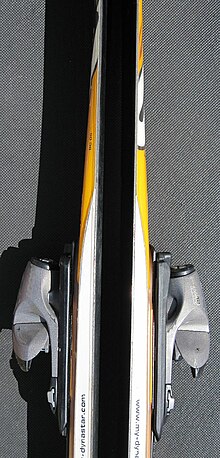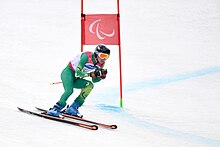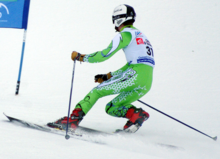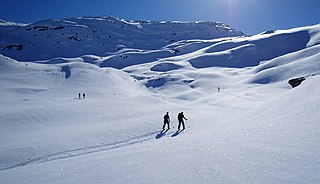
Cross-country skiing is a form of skiing whereby skiers traverse snow-covered terrain without use of ski lifts or other assistance. Cross-country skiing is widely practiced as a sport and recreational activity; however, some still use it as a means of travel. Variants of cross-country skiing are adapted to a range of terrain which spans unimproved, sometimes mountainous terrain to groomed courses that are specifically designed for the sport.

Snowboards are boards where the user places both feet, usually secured, to the same board. The board itself is wider than most skis, with the ability to glide on snow. Snowboards widths are between 6 and 12 inches or 15 to 30 centimeters. Snowboards are differentiated from monoskis by the stance of the user. In monoskiing, the user stands with feet inline with direction of travel, whereas in snowboarding, users stand with feet transverse to the longitude of the board. Users of such equipment may be referred to as snowboarders. Commercial snowboards generally require extra equipment such as bindings and special boots which help secure both feet of a snowboarder, who generally ride in an upright position. These types of boards are commonly used by people at ski hills, mountains, backcountry, or resorts for leisure, entertainment, and competitive purposes in the activity called snowboarding.

Skiing is the use of skis to glide on snow. Variations of purpose include basic transport, a recreational activity, or a competitive winter sport. Many types of competitive skiing events are recognized by the International Olympic Committee (IOC), and the International Ski and Snowboard Federation (FIS).

Alpine skiing, or downhill skiing, is the pastime of sliding down snow-covered slopes on skis with fixed-heel bindings, unlike other types of skiing, which use skis with free-heel bindings. Whether for recreation or for sport, it is typically practiced at ski resorts, which provide such services as ski lifts, artificial snow making, snow grooming, restaurants, and ski patrol.

Skiing, or traveling over snow on skis, has a history of at least eight millennia. The earliest archaeological examples of skis were found in Karelia and date to 6000 BCE. Although skiing's origins were purely utilitarian, the modern sport evolved from beginnings in Scandinavia, starting in the mid-1800s skiing became a popular recreational activity and sport, becoming practiced in snow-covered regions worldwide, and providing a market for the development of ski resorts and their related communities.
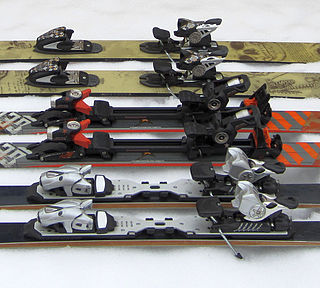
A ski binding is a device that connects a ski boot to the ski. Before the 1933 invention of ski lifts, skiers went uphill and down and cross-country on the same gear. As ski lifts became more prevalent, skis—and their bindings—became increasingly specialized, differentiated between alpine (downhill) and Nordic styles of skiing. Until the point of divergence in the mid-20th century, bindings held the toe of a flexible, leather boot against the ski and allowed the heel to rise off the ski, typically with a form of strap or cable around the heel.
Ski boots are footwear used in skiing to provide a way to attach the skier to skis using ski bindings. The ski/boot/binding combination is used to effectively transmit control inputs from the skier's legs to the snow.

Ski wax is a material applied to the bottom of snow runners, including skis, snowboards, and toboggans, to improve their coefficient of friction performance under varying snow conditions. The two main types of wax used on skis are glide waxes and grip waxes. They address kinetic friction—to be minimized with a glide wax—and static friction—to be achieved with a grip wax. Both types of wax are designed to be matched with the varying properties of snow, including crystal type and size, and moisture content of the snow surface, which vary with temperature and the temperature history of the snow. Glide wax is selected to minimize sliding friction for both alpine and cross-country skiing. Grip wax provides on-snow traction for cross-country skiers, as they stride forward using classic technique.

Ski touring is skiing in the backcountry on unmarked or unpatrolled areas. Touring is typically done off-piste and outside of ski resorts, and may extend over a period of more than one day. It is similar to backcountry skiing but excludes the use of a ski lift or transport.

A monoski is a single wide ski used for skiing on snow. The same boots, bindings, and poles are used as in alpine skiing. Unlike in snowboarding, both feet face forward, rather than sideways to the direction of travel. Similar equipment includes the skwal and the teleboard, with feet in tandem formation.

A carved turn is a skiing and snowboarding term for the technique of turning by shifting the ski or snowboard onto its edges. When edged, the sidecut geometry causes the ski to bend into an arc, and the ski naturally follows this arc shape to produce a turning motion. The carve is efficient in allowing the skier to maintain speed because, unlike the older stem Christie and parallel turns, the skis do not create drag by sliding sideways.

Ski geometry is the shape of the ski. Described in the direction of travel, the front of the ski, typically pointed or rounded, is the tip, the middle is the waist and the rear is the tail. Skis have four aspects that define their basic performance: length, width, sidecut and camber. Skis also differ in more minor ways to address certain niche roles. For instance, skis for moguls are much softer to absorb shocks from the quick and sharp turns of the moguls and skis for powder are much wider to provide more "float" in deeper, softer snow.
4FRNT Skis is an independent brand of alpine ski equipment that helped to pioneer the development of the freeskiing movement. 4FRNT introduced the model of a rider-owned and operated ski company to the sport.
The Head Standard was Howard Head's first successful ski design, and arguably the first modern downhill ski. The Standard used composite construction, with a plywood core sandwiched between aluminum outer skins, steel edges tapering into the core, and a hard plastic base, sidewalls and topsheet. The only major changes in ski materials since the Standard are the use of fibreglass structural layers in place of the aluminum layers, and substitution of expanded plastic foam for the wooden core.

Look's Nevada, released in 1950, was the first recognizably modern alpine ski binding. The Nevada was only the toe portion of the binding, and was used with a conventional cable binding for the heel. An updated version was introduced in 1962 with a new step-in heel binding, the Grand Prix. These basic mechanisms formed the basis for LOOK bindings for over 40 years, changing mainly in name and construction materials. The Nevada toe pattern is almost universal among bindings today.

Cable bindings, also known as Kandahar bindings or bear-trap bindings, are a type of ski bindings widely used through the middle of the 20th century. It was invented and brand-named after the Kandahar Ski Club in 1929 by ski racer and engineer Guido Reuge. They were replaced in alpine skiing by heel-and-toe "safety bindings" in the mid-1960s.
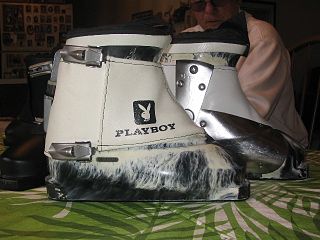
Rosemount Ski Boots introduced one of the earliest all-plastic ski boots for the downhill skiing market, competing with Bob Lange for the title of "first". Rosemount's design was easily distinguished by its use of the uncommon "side-entry" method for putting the boot on, which was rare at the time and is no longer used.

Lange is a major producer of ski boots used in alpine (downhill) skiing, founded in 1948 in the USA. They introduced the world's first plastic ski boots in 1962, and a greatly improved model aimed at the racing market in 1965. After several World Cup and Olympics wins in 1967 and 1968 made them a must-have on the circuit, Lange has remained a force in the racing market ever since. Their boots have equipped five times as many World Cup medal winners as any other brand into the 2000s. The front-entry design introduced by Lange is used by almost every modern ski boot to this day. Lange remains a major brand worldwide.
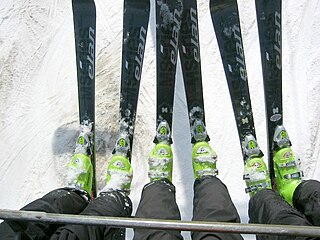
The SCX, for "SideCut eXtreme", was an alpine ski introduced by Elan in the winter of 1993/4. Skis before the SCX had almost always used a shape that was slightly curved inward on the sides, typically by 7 millimetres (0.28 in) compared to a straight line running from tip to tail. The SCX was designed with over 22 millimetres (0.87 in) "sidecut", producing a wasp-waisted ski unlike anything on the market.
This glossary of skiing and snowboarding terms is a list of definitions of terms and jargon used in skiing, snowboarding, and related winter sports.






